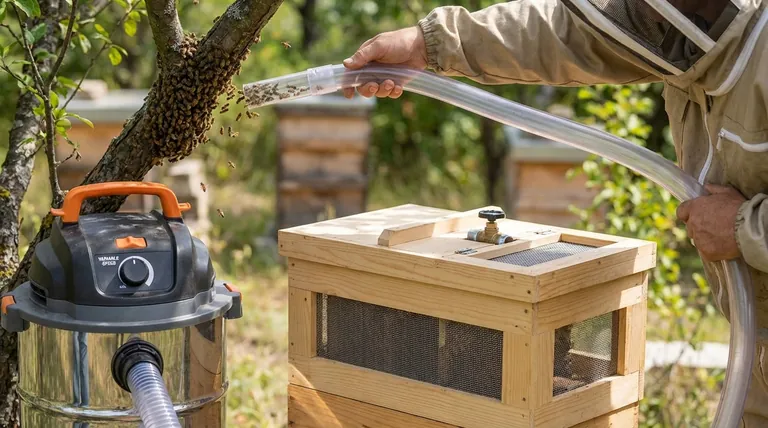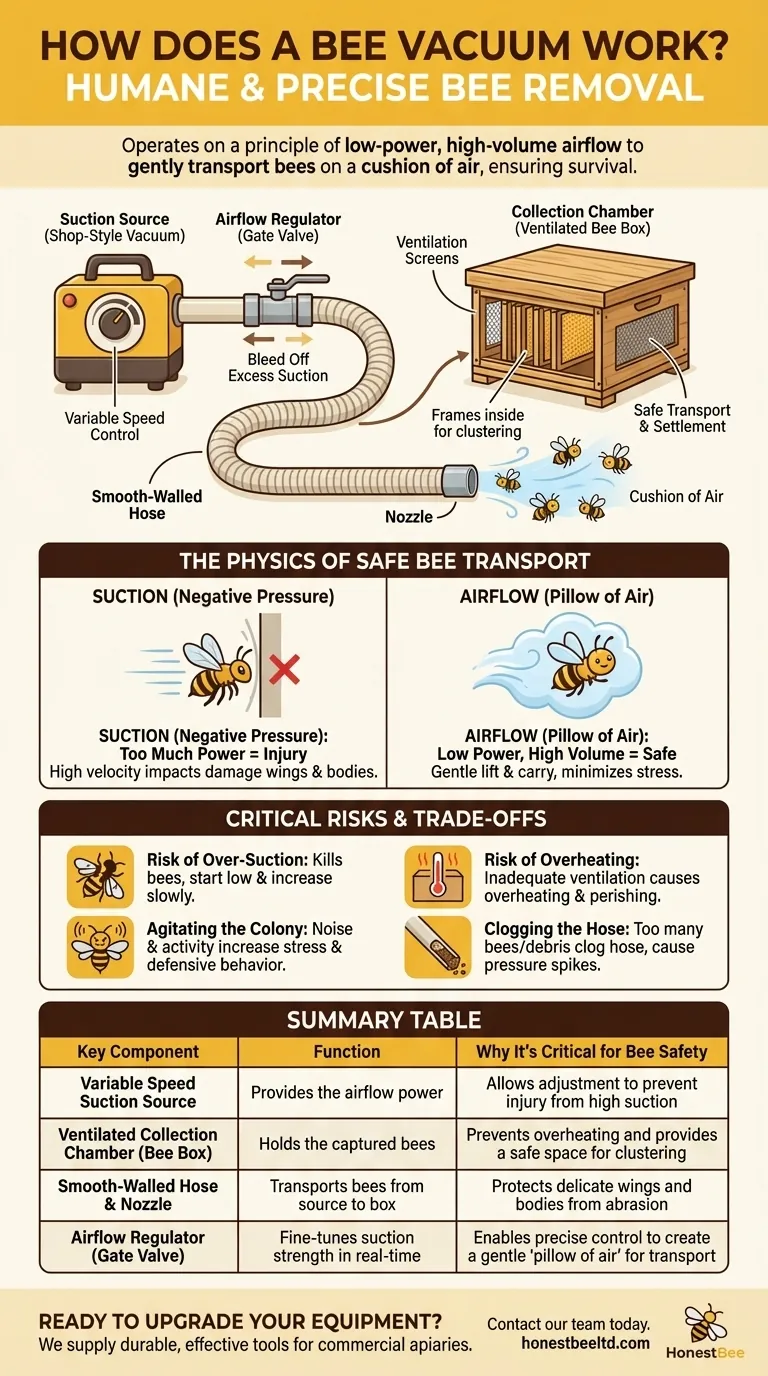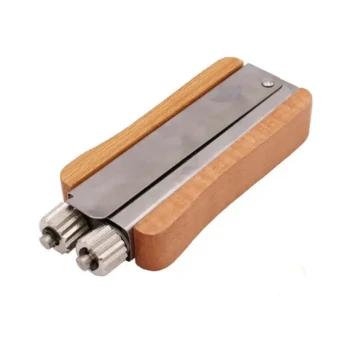At its core, a bee vacuum is a specialized tool for humane bee removal. Unlike a household vacuum designed for dirt, a bee vacuum operates on a principle of low-power, high-volume airflow. It uses gentle, controlled suction to draw bees from a swarm or an established hive into a secure collection chamber without causing them injury or death.
The effectiveness of a bee vacuum isn't just about suction; it's about achieving a precise balance between airflow and pressure. The goal is to gently lift and transport bees on a cushion of air, ensuring their survival for relocation.

The Anatomy of a Bee Vacuum
To understand how it works, it's best to look at its fundamental components. Each part is designed to protect the bees during their short journey.
The Suction Source
The "engine" of the system is typically a shop-style vacuum. The critical feature is not power, but variable speed control. The ability to dial the motor's power up or down is essential for adjusting the suction strength.
The Collection Chamber
This is the most significant difference from a standard vacuum. Instead of a bag or canister meant for debris, a bee vacuum uses a dedicated bee box. This is often a modified beehive box (a "nuc" or nucleus box) with proper ventilation screens. Some designs even include frames so the bees have a surface to cluster on immediately.
The Hose and Nozzle
The hose must have a smooth interior wall. A corrugated hose, common on household vacuums, can be abrasive and damage a bee's delicate wings and body. The nozzle is simply the open end of the hose, used to gently guide bees into the airflow.
The Airflow Regulator
This is the most critical component for fine-tuning the system. A gate valve is installed in the vacuum hose or on the lid of the collection box. By opening or closing this gate, the operator can bleed off excess suction, allowing for precise, real-time adjustments to the airflow without touching the vacuum motor itself.
The Physics of Safe Bee Transport
The principle that makes a bee vacuum safe is often misunderstood. It's less about "sucking" and more about "carrying."
Airflow vs. Suction
Suction (negative pressure) is the force that pulls bees off a surface. Too much suction can slam them against the hose walls, causing fatal injuries. Airflow, measured in cubic feet per minute (CFM), is the volume of air moving through the hose. The goal is to use just enough suction to lift the bee and then let a high volume of moving air carry it safely.
The "Pillow of Air"
An effective way to visualize this is to imagine the bees are not being pulled, but rather floating on a pillow of moving air. This gentle transport minimizes stress and prevents the tumbling, violent action seen in a regular vacuum cleaner.
Why Low Power is Essential
A bee's body is fragile. High-velocity impacts can easily dismember them, tear wings, or cause lethal internal damage. By keeping the power low, the bees travel at a safe speed until they are deposited into the collection chamber, where the air disperses and they can settle.
Understanding the Trade-offs and Risks
While highly effective, using a bee vacuum requires skill and an understanding of its potential dangers.
Risk of Over-Suction
This is the most common mistake. Using too much power will kill bees, defeating the primary purpose of the tool. It is always better to start with too little suction and increase it slowly.
Risk of Overheating
Thousands of bees packed into a collection box generate a significant amount of heat. Inadequate ventilation in the box can cause the colony to overheat and perish, especially on a warm day.
Agitating the Colony
The noise and activity of the vacuum can be stressful for the bees. This can make them more defensive, increasing the risk of stings for the operator. A calm, steady approach is crucial.
Clogging the Hose
Attempting to vacuum too many bees at once or sucking up pieces of honeycomb or debris can clog the hose. This can cause dangerous pressure spikes or require shutting down the operation to clear the blockage.
How to Apply This to Your Goal
Your approach to using a bee vacuum should depend on your specific objective.
- If your primary focus is removing an exposed swarm: You need a simple, portable setup with a well-ventilated collection box, as the job is typically straightforward.
- If your primary focus is a "cut-out" from a structure: You require a longer hose to reach into wall cavities and a very responsive airflow gate to manage bees, comb, and debris.
- If you are building your own (DIY): The most critical component to invest in is an adjustable air gate or a variable speed controller for your motor; always test your setup on just a few bees before tackling a full colony.
Mastering a bee vacuum is an exercise in gentle, precise control that prioritizes the well-being of the colony.
Summary Table:
| Key Component | Function | Why It's Critical for Bee Safety |
|---|---|---|
| Variable Speed Suction Source | Provides the airflow power | Allows adjustment to prevent injury from high suction |
| Ventilated Collection Chamber (Bee Box) | Holds the captured bees | Prevents overheating and provides a safe space for clustering |
| Smooth-Walled Hose & Nozzle | Transports bees from source to box | Protects delicate wings and bodies from abrasion |
| Airflow Regulator (Gate Valve) | Fine-tunes suction strength in real-time | Enables precise control to create a gentle 'pillow of air' for transport |
Ready to upgrade your bee removal or beekeeping operation with professional-grade equipment?
At HONESTBEE, we supply commercial apiaries and beekeeping equipment distributors with durable, effective tools designed for demanding use. Our wholesale-focused operations mean you get reliable equipment that prioritizes bee welfare and operator efficiency.
Let us help you equip your business for success. Contact our team today to discuss your specific needs and explore our range of beekeeping supplies.
Visual Guide

Related Products
- HONESTBEE Professional Long Handled Hive Tool with Precision Cutting Blade
- HONESTBEE Advanced Ergonomic Stainless Steel Hive Tool for Beekeeping
- Professional Dual-End Stainless Steel Hive Tool for Beekeeping
- Wholesales Dadant Size Wooden Bee Hives for Beekeeping
- Professional 3-Bar Frame Grip with Integrated Hive Tool
People Also Ask
- How can a hive tool be used to remove propolis and burr comb? Master Hive Maintenance for a Healthy Colony
- Why do hive tools have a hole? Unlock the Secret to Efficient Beekeeping
- What are the features of a regular hive tool? The Essential Multi-Tool for Every Beekeeper
- How should beekeepers handle bees when using a hive tool? Master Calm, Deliberate Techniques
- What are some common uses of a hive tool? Essential Multi-Purpose Tool for Every Beekeeper



















